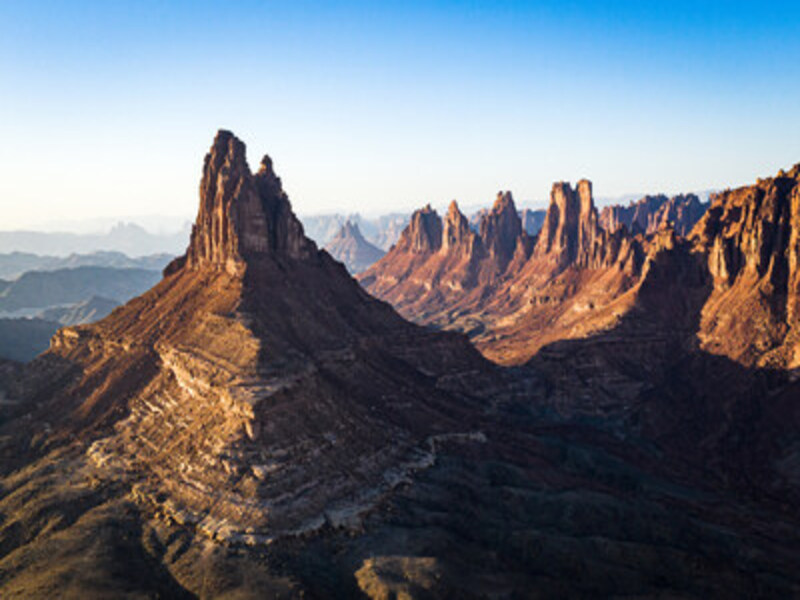Reading Time: 4 minutes
Today, under the leadership of His Royal Highness Prince Mohammed bin Salman bin Abdulaziz Al Saud, Crown Prince, the Board of Directors of the Prince Mohammed bin Salman Royal Reserve The Development Authority introduced the Comprehensive Plan for Managing the Reserve’s Development. This newly introduced plan serves as a detailed roadmap, aligning with global standards and addressing the environmental, economic, social, tourism, and cultural dimensions of the expansive 24,500 square kilometer Reserve. The Reserve is home to 15 unique ecosystems, ranging from mountain ranges to coral reefs located in the Kingdom’s northwest.
The IDMP lays out a framework for the Reserve’s efficient and sustainable management, establishing guidelines for wildlife restoration and conservation according to the latest international standards. This includes species reintroduction efforts supported by modern technologies, as well as the development and enhancement of the ecotourism ecosystem within the Reserve. One notable aspect of this plan is its integration with Red Sea Global’s AMAALA tourism initiative, situated within the Reserve. Additionally, four sites within the Reserve are listed on the UNESCO World Heritage Tentative List, and the plan aspires to elevate the Reserve into a globally renowned heritage tourism destination that harmonizes environmental preservation with the needs of local communities.
The creation of the Integrated Development Management Plan follows a series of in-depth studies examining the Reserve’s historical and current environmental conditions, outlining steps to restore its ecosystems, flora, and fauna to their state from a century ago. The Reserve, characterized by its rich biodiversity, encompasses 15 distinct ecosystems, from mountainous regions and life-sustaining wadis to the coral reefs of the Red Sea. The plan includes a wildlife reintroduction program focusing on 23 species historically native to the area, 16 of which are currently extinct within the Reserve. The program also targets species listed as Critically Endangered and Vulnerable by the IUCN, including the Arabian oryx, Arabian leopard, and cheetah. To support these reintroduction efforts, a comprehensive habitat restoration project is also underway, aimed at protecting and conserving the Reserve’s over 400 native plant species. Ultimately, the Reserve is poised to become a premier destination for tourists, offering a unique blend of terrestrial and marine experiences while prioritizing the protection of its ecosystems and biodiversity.
Saudi Arabia remains dedicated to collaborating with the global community to tackle pressing environmental challenges. Key initiatives, such as reducing carbon emissions with the goal of achieving net-zero by 2060, expanding the Kingdom’s renewable energy infrastructure, increasing reforestation efforts, and enhancing biodiversity through wildlife reintroductions, are actively being pursued. The launch of the IDMP bolsters the Kingdom’s leadership in wildlife reintroduction and conservation, aligning with the strategic goals of the Royal Reserves Council. These goals emphasize wildlife protection, afforestation, ecotourism development, and job creation. The objectives of the Royal Reserves also reinforce Saudi Arabia’s commitment to sustainability and environmental conservation, contributing to the Saudi Green Initiative’s target of protecting 30% of the Kingdom’s terrestrial and marine areas by 2030.
Andrew Zaloumis, CEO of the Prince Mohammed bin Salman Royal Reserve Development Authority, internationally recognized for his pioneering work in establishing reserves of global conservation value and regional economic impact, said:
“The building blocks are in place to deliver the promise of the IDMP by 2030 – a Reserve of global conservation significance rooted in community.”
We have reintroduced animal species, discovered several species new to science, and trained and deployed an effective ranger team of 150 local men and women who play a pivotal role in our mission.”
“Thanks to the passion of the Saudi Arabian leadership and the investment and commitment of the government, we are pioneering new techniques and technologies to complement tried and tested management and conservation practices.”
“We look forward to sharing the results of our work with the wider conservation and scientific community.”
The Prince Mohammed bin Salman Royal Reserve Development Authority is comprised of both local and international experts who spearhead research and development initiatives. Their efforts focus on strengthening international and local partnerships, fostering cooperation, and facilitating the exchange of knowledge to implement top-tier environmental practices. Their research has led to the discovery of new species of flora and fauna within the Reserve’s varied terrestrial and marine environments.
Strategically positioned to link major projects like NEOM, AMAALA, Red Sea Global, and AlUla, the Reserve spans diverse ecosystems. Through collaborations with numerous specialized local and global organizations, the plan is to establish a 70,000 km² environmental corridor by 2025, where wildlife can move freely. This corridor is set to play a pivotal role in regional environmental restoration efforts, enhance ecotourism, and provide balanced opportunities for the local communities, including the creation of approximately 5,400 jobs.
Prince Mohammed bin Salman Royal Reserve is among the eight Royal Reserves established by Royal Decree and managed by the Royal Reserves Council, chaired by His Royal Highness the Crown Prince. The other reserves include Imam Abdulaziz bin Mohammed Royal Reserve, Imam Saud bin Abdulaziz Royal Reserve, Imam Turki bin Abdullah Royal Reserve, King Abdulaziz Royal Reserve, King Salman bin Abdulaziz Royal Reserve, King Khalid Royal Reserve, and Imam Faisal bin Turki Royal Reserve.
The post Saudi Arabia’s Crown Prince Unveils Strategic Tourism Plan for the Prince Mohammed bin Salman Royal Reserve, Showcasing 15 Unique Ecosystems appeared first on Travel And Tour World.

